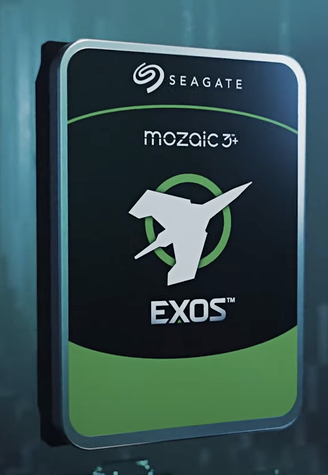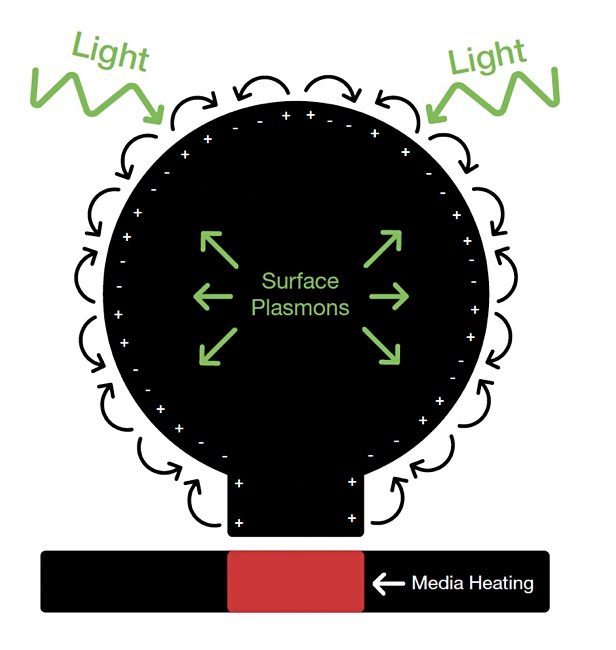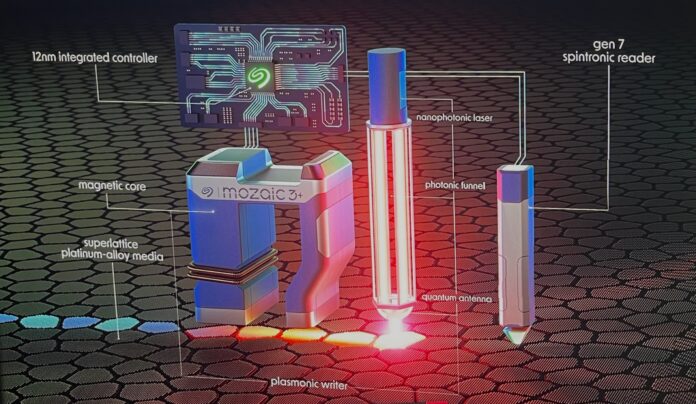Seagate is announcing 30-plus TB Exos HAMR disk drives almost five years after aiming for 20 TB HAMR drive shipments in 2019.
Update: Some Exos Mozaic 3+ product details added. 18 January 2024. More product details added 19 January 2024.
The complex Mozaic 3+ technology has taken years to refine and develop, with Seagate working on the technology’s reliability, yield, and manufacturing cost. Now it is able to qualify and start mass-producing the drives, with 10 x 3 TB platters. This gives it a 6 TB capacity advantage over arch-rival Western Digital with its 24 TB conventional and 28 TB shingled drives. Seagate will have shingled HAMR drives too, at the 32 TB level. This capacity jump is coming with generative AI poised to increase the need for data to be stored on disks and datacenter power concerns encouraging clients to move to fewer and larger capacity drives to lower electricity usage.
Dave Mosley, Seagate CEO, said in a statement: “Seagate is the world’s only hard drive manufacturer with the areal density capability to get to 3 TB per platter and with 5 TB on the horizon. As AI use cases put a premium on raw data sets, more companies are going to need to store all the data they can. To accommodate the resulting masses of data, areal density matters more than ever.”

The average disk capacity in large-scale datacenters is 16 TB using conventional perpendicular magnetic recording (PMR) drives. Upgrading to an Exos 30 TB Mozaic 3+ technology drive almost doubles capacity in the same footprint. CTO John Morris told us: “We are approaching the point of full qualification of our first product with this technology. It’ll be this quarter. And that means … we will initiate the volume ramp of the product” this quarter.
Seagate said it is experiencing strong demand from datacenter customers that are expected to complete qualification of Mozaic 3+ and move into volume ramp. Exos 30-plus TB products will be shipping in volume this quarter to hyperscale cloud customers.
They will be produced in three versions:
- Conventional at 24 TB and 30 TB
- Shingled (SMR) with overlapping write tracks providing higher capacity and slower writes at 32 TB
- Hybrid SMR with conventional and shingled zones at around 24-30 TB for CSPs such as Google
Technology
Seagate’s HAMR Mozaic 3+ platform is a collection of component technologies, starting with a superlattice iron-platinum alloy for the media recording layer. This has a smaller grain size than is possible with current disk drive media, and a high coercivity or resistance to magnetic pole direction change at room temperature levels. Applying intense, highly localized heat to a bit area lowers the coercivity, enabling data bits to be written as magnetic pole directions – north or south.
Data bits are written to the media using a plasmonic writer, which has several elements to it. These start with a nano-photonic laser. Its 830 nm light photon pulses pass through a photonic tunnel or wave guide to a quantum antenna, a near field transducer, which focuses them on a 35 nm spot on the media surface, thus heating it up to more than 400°C.

This spot is much smaller than the laser’s 830 nm output area. Morris said normal optics could focus the laser pulse down to around 200 nm, “but because we’re using this plasmonic effect, we can produce spots that are much smaller than the diffraction limit that you would get with normal optics. We’re actually creating spots that are more like 35 nanometers with this laser.
“The photons from the laser interact with the antenna. It creates a collective excitation of electrons that resonate. And we can couple that resonance through the antenna directly into the media and create a very precisely defined and very small spot of energy in the media.”

The plasmonic effect happens in the quantum antenna, which is a plasmonic resonator. Photons impinge on a disk-like metal surface and instantiate an electric current on the surface with an associated electromagnetic field, a surface plasmon. The surface plasmons move along the disk’s edge and round it to a metal peg facing the disk platter’s media surface. The peg’s width is 35 nm and the plasmons on it heat the media’s surface below the peg in a 35 nm spot.
Once written, the bit area spot cools and its magnetic pole direction is stable. The heating and cooling cycle takes about a nanosecond. Although the disk is actually spinning at 7,200 rpm, the laser pulse happens so quickly that it is as if the disk is momentarily still beneath the quantum antenna.
There is more work to be done. Seagate plans to vertically integrate the nanophotonic laser into the plasmonic writer sub-system. Mosley said: “Developing this unique laser technology in-house for Mozaic 3+ will ensure even greater efficiency and yield to support rapid scaling of volume production.”
Recorded data bits are read using Seagate’s latest, seventh generation spintronic reader, with its geometry changed to read data from the smaller bit area than before.
The whole read-write subsystem is managed by a system-on-chip controller built in-house by Seagate with 12 nm technology.
Seagate is plugging the green credentials of its HAMR technology, saying Mozaic 3+ offers a 55 percent reduction in embodied carbon per terabyte (when comparing a 30 TB Mozaic 3+ drive with a traditional 16 TB PMR drive).
Product details
The Exos Mozaic 3+ drives are helium-filled, have a 2.5 million hours MTBF rating and a 5-year warranty. They only have a 6Gbps SATA interface, with a Seagate spokesperson saying: “over 90 percent of our highest capacity HDD volume is on this interface. We plan to add the 12gig SAS interface on Mozaic 4+ in 2025.”
There is a 512MB cache. The maximum sustained data transfer rate is 275MBps, slower than the conventional Exos X24 24TB drive’s 285 MBps. The spokesperson said:”The data rate and IOPS for Mozaic 3+ drives is comparable with previous nearline products in the marketplace. The focus of the Mozaic 3+ was growing areal density to add to the primary value that nearline drives bring to the HDD tier of storage.”
The Exos Mozaic 3+ 24 TB drive has 8 x 3 TB platters.
Seagate has not published a product data sheet for the Mosaic 3+ drives. They are only on sale to CSPs for now and a datasheet will be provide when channel sales start next quarter.
Roadmap
Seagate provided a HAMR drive capacity increase roadmap. Morris said: “We’re providing a timeline for when we’ll get to Mozaic four, which is a four terabyte per disk configuration. And when we’ll get to Mozaic five, which is a a five terabyte per disk configuration.”

By “disk” here he is referring to the drive’s platters, not the whole drive. Mozaic 4+ will deliver 40-plus TB drives and Mozaic 5+ will get Seagate to the 50 TB level.
Market need and competition
Seagate quotes IDC figures saying that between 2022 and 2025 the global datasphere will more than double. The generative AI boom is expected to boost stored data needs. Morris said: “We fully expect to see an AI-related storage demand [increase to] occur, likely as a lagging response to the AI, infrastructure investments.”
This all means that more data needs to be stored against a background of datacenters pressed to supply electricity to GPU servers, leaving less to power and cool disk cabinets. Filling these with higher-capacity drives that need fewer watts per TB with existing drives means floor space can be saved and fewer disks need to be cooled.
What this leads to is Seagate having a stronger competitive position versus Western Digital and Toshiba. Both of these companies are using technologies associated with microwave-assisted magnetic recording (MAMR) to push capacities of their conventional, PMR drives higher.
With Western Digital at 24 TB conventional and 28 TB shingled, and Toshiba at 22 TB conventional, both are at a capacity disadvantage.
The two companies have said they will move to HAMR technology in the future. With Seagate looking to move to 40 TB conventional/46-48 TB shingled by late 2026, and 50 TB conventional and 56-60 TB shingled capacity levels by late 2028, their HAMR migration may have to take place sooner rather than later.
Seagate intends to move all of its drive products to HAMR tech, lowering the platter count and hence the cost of sub-30TB drives. For example, a 20 TB drive with 10 x 2 TB platters becomes a 7 x 3 TB platter drive with HAMR tech, saving on both platter and read/write head costs, and also power consumption – fewer platters for the drive motor to spin.
Seagate looks to have substantial capacity, cost/TB, and electrical (watts/TB) product advantages over its competitors.
Bootnote
The 32 TB SMR drive has a mere 2TB or 6.66 percent more capacity than the 32 TB non-SMR drive. This is curious as Seagate’s current Exos X 24 PMR drive has a 28 TB SMR version; 4TB or 16.66 percent extra capacity, suggesting that HAMR tracks don’t provide as much scope for shingling as PMR tracks. We’re checking this with Seagate.
Anandtech reports Seagate is working with vendors such as Showa-Denko (platters) and TDK (read/write heads) on the HAMR drives. Seagate hinted it has exclusive use of such tech for a period of time, limiting Toshiba and Western Digital’s ability to take advantage of them. The Exos Mozaic 3+ technology will move to Seagate’s other 3.5-inch disk product families such as IronWolf NAS and SkyHawk video surveillance drives.








